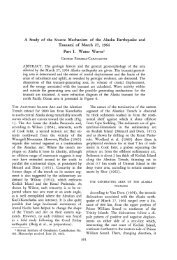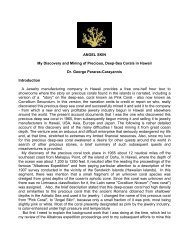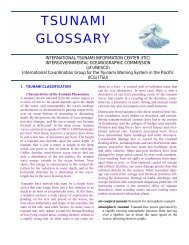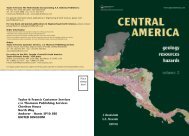vulnerabilities - strategies for mitigating impacts - Disaster Pages of ...
vulnerabilities - strategies for mitigating impacts - Disaster Pages of ...
vulnerabilities - strategies for mitigating impacts - Disaster Pages of ...
You also want an ePaper? Increase the reach of your titles
YUMPU automatically turns print PDFs into web optimized ePapers that Google loves.
Architects and engineers involved in the design and construction <strong>of</strong> critical infrastructure facilities<br />
usually design and build in accordance to codes that provide adequately <strong>for</strong> static loads. Often,<br />
however, the structural <strong>vulnerabilities</strong> <strong>of</strong> critical structures to extreme loading <strong>of</strong> dynamic <strong>for</strong>ces<br />
associated with natural disasters are overlooked or underestimated. Even if the critical structures<br />
survive the initial dynamic <strong>for</strong>ces associated with a disaster, <strong>of</strong>ten-progressive collapse can occur<br />
from loss in strength <strong>of</strong> materials, when repeated cycles <strong>of</strong> dynamic <strong>for</strong>ces continue. An example is<br />
the destruction to buildings in the coastal area <strong>of</strong> the Sea <strong>of</strong> Marmara from the 1999 earthquake in<br />
Turkey. Although well designed <strong>for</strong> static loads, most <strong>of</strong> the buildings that were destroyed were<br />
located in coastal areas, reclaimed land, and areas underlain with unconsolidated sediments. The<br />
strong earthquake motions caused liquefaction <strong>of</strong> the foundations and the buildings collapsed or sank<br />
in the sea. The subsequent tsunami completed the destruction.<br />
8.2 Engineering Considerations<br />
Each disaster requires a different type <strong>of</strong> extensive engineering analysis <strong>for</strong> calculating the impact<br />
on structures or on resources. In this section, and as an example only, we will address briefly some <strong>of</strong><br />
the engineering considerations <strong>of</strong> potential seismic <strong>impacts</strong>.<br />
Earthquakes generate many different waves. The most destructive <strong>of</strong> the seismic waves are those<br />
that travel on the surface and induce dynamic vertical and lateral accelerations on structures. These<br />
<strong>for</strong>ces <strong>of</strong>ten result in ground liquifaction particularly in areas that are underlain by unconsolidated<br />
sediments. Liquefaction may result in the settling/sinking/tilting/cracking <strong>of</strong> the entire structure or the<br />
separation from the superstructure from the foundations. Damage to structures is not limited to the<br />
effects <strong>of</strong> liquefaction. Damage could occur with full liquefaction, partial liquefaction or no<br />
liquefaction at all. Damage could occur simply from strong ground motions. Enhancement <strong>of</strong> ground<br />
motions could occur in alluvial deposits even in the absence <strong>of</strong> liquefaction. It is not liquefaction that<br />
causes strong motions. The rupture geometry <strong>of</strong> the seismic source region can affect the directivity<br />
and frequency <strong>of</strong> the surface seismic waves. Furthermore the surface waves could separate into trains<br />
<strong>of</strong> certain periods. Waves <strong>of</strong> certain periods could enhance the ground accelerations (vertical and<br />
horizontal) particularly in alluvial sediments. For example, most <strong>of</strong> the damage at the Mexico City<br />
earthquake resulted from maximum ground accelerations caused by a single monochromatic surface<br />
seismic wave traveling within a 30 ft. layer <strong>of</strong> sediments (Pararas-Carayannis, 1985). Downtown<br />
Mexico City has been built on sediments <strong>of</strong> a dry lake (which existed when Cortez and the Spaniards<br />
arrived in 1541). The Aztecs lived on an island on that lake.<br />
It is outside the scope <strong>of</strong> the present report to comment on specific engineering guidelines. It will<br />
suffice to state that the structural failures <strong>of</strong> critical structures from the dynamic <strong>for</strong>ces <strong>of</strong> disasters<br />
can be prevented with proper analysis and per<strong>for</strong>mance studies, proper retr<strong>of</strong>itting <strong>of</strong> buildings and<br />
proper land use. Thus, specific design and construction <strong>strategies</strong> are essential in minimizing the<br />
impact <strong>of</strong> disasters on critical infrastructures facilities and in assuring continuity <strong>of</strong> operations in the<br />
post disaster period.<br />
8.3 Early Warning Systems<br />
Finally, early warning systems <strong>for</strong> natural and manmade disasters provide the best means <strong>for</strong><br />
<strong>mitigating</strong> losses <strong>of</strong> human lives. Usually, an early warning system detects the disaster in real time<br />
and determines the type, magnitude, speed, direction, and the expected geographic area that will be<br />
27








